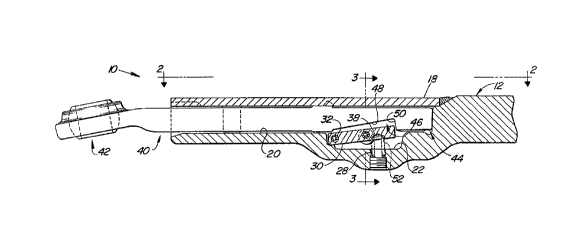Une partie des informations de ce site Web a été fournie par des sources externes. Le gouvernement du Canada n'assume aucune responsabilité concernant la précision, l'actualité ou la fiabilité des informations fournies par les sources externes. Les utilisateurs qui désirent employer cette information devraient consulter directement la source des informations. Le contenu fourni par les sources externes n'est pas assujetti aux exigences sur les langues officielles, la protection des renseignements personnels et l'accessibilité.
L'apparition de différences dans le texte et l'image des Revendications et de l'Abrégé dépend du moment auquel le document est publié. Les textes des Revendications et de l'Abrégé sont affichés :
| (12) Brevet: | (11) CA 2114062 |
|---|---|
| (54) Titre français: | ATTELAGE TELESCOPIQUE VERROUILLABLE |
| (54) Titre anglais: | EXTENDABLE LATCHABLE DRAFT LINK |
| Statut: | Réputé périmé |
| (51) Classification internationale des brevets (CIB): |
|
|---|---|
| (72) Inventeurs : |
|
| (73) Titulaires : |
|
| (71) Demandeurs : |
|
| (74) Agent: | BORDEN LADNER GERVAIS LLP |
| (74) Co-agent: | |
| (45) Délivré: | 1997-12-30 |
| (22) Date de dépôt: | 1994-01-24 |
| (41) Mise à la disponibilité du public: | 1994-07-28 |
| Requête d'examen: | 1994-01-24 |
| Licence disponible: | S.O. |
| (25) Langue des documents déposés: | Anglais |
| Traité de coopération en matière de brevets (PCT): | Non |
|---|
| (30) Données de priorité de la demande: | ||||||
|---|---|---|---|---|---|---|
|
Assemblage de pièces de traction télescopique comportant un premier élément creux rattaché au tracteur et un deuxième élément relié à l'engin remorqué qui peut s'insérer par glissement dans un canal du premier élément. Une plaque est montée dans un logement contigu au canal. Cette plaque est en mesure de tourner d'une position de dégagement, pour laquelle cette plaque est entièrement située dans le logement, à une position de verrouillage, pour laquelle une partie au moins de la plaque dépasse dans le canal. Le deuxième élément comporte une encoche, une extrémité de cette encoche formant un épaulement susceptible de s'engager avec la plaque pour maintenir le deuxième élément en position rétractée jusqu'à ce que la plaque soit dégagée. Un ressort comprimé oblige la plaque à conserver sa position de verrouillage et un bouton, fixé à la plaque, permet à un opérateur de faire tourner la plaque en position de dégagement.
A telescoping draft link assembly includes a hollow first
tractor-coupled link and a second implement-coupled link
slidably received by a channel in the first link. A pocket is
formed in the first link next to the channel. A plate is
pivotally mounted in the pocket and is pivotal from a release
position wherein the plate is entirely received in the pocket
to a locking position wherein at least a portion of the plate
projects into the channel. The second link has a notch formed
therein, an end of the notch forming a shoulder which is
engageable with the plate to releasably hold the second link
in the retracted position. A spring is biased to urge the
plate towards its locking position and a knob is attached to
the plate so that an operator may pivot the plate to a release
position.
Note : Les revendications sont présentées dans la langue officielle dans laquelle elles ont été soumises.
Note : Les descriptions sont présentées dans la langue officielle dans laquelle elles ont été soumises.

Pour une meilleure compréhension de l'état de la demande ou brevet qui figure sur cette page, la rubrique Mise en garde , et les descriptions de Brevet , États administratifs , Taxes périodiques et Historique des paiements devraient être consultées.
| Titre | Date |
|---|---|
| Date de délivrance prévu | 1997-12-30 |
| (22) Dépôt | 1994-01-24 |
| Requête d'examen | 1994-01-24 |
| (41) Mise à la disponibilité du public | 1994-07-28 |
| (45) Délivré | 1997-12-30 |
| Réputé périmé | 2005-01-24 |
Il n'y a pas d'historique d'abandonnement
| Type de taxes | Anniversaire | Échéance | Montant payé | Date payée |
|---|---|---|---|---|
| Le dépôt d'une demande de brevet | 0,00 $ | 1994-01-24 | ||
| Enregistrement de documents | 0,00 $ | 1994-07-29 | ||
| Taxe de maintien en état - Demande - nouvelle loi | 2 | 1996-01-24 | 100,00 $ | 1996-01-23 |
| Taxe de maintien en état - Demande - nouvelle loi | 3 | 1997-01-24 | 100,00 $ | 1997-01-23 |
| Taxe finale | 300,00 $ | 1997-09-10 | ||
| Taxe de maintien en état - brevet - nouvelle loi | 4 | 1998-01-26 | 100,00 $ | 1998-01-23 |
| Taxe de maintien en état - brevet - nouvelle loi | 5 | 1999-01-25 | 150,00 $ | 1999-01-22 |
| Taxe de maintien en état - brevet - nouvelle loi | 6 | 2000-01-24 | 150,00 $ | 2000-01-21 |
| Taxe de maintien en état - brevet - nouvelle loi | 7 | 2001-01-24 | 150,00 $ | 2001-01-23 |
| Taxe de maintien en état - brevet - nouvelle loi | 8 | 2002-01-24 | 150,00 $ | 2002-01-23 |
| Taxe de maintien en état - brevet - nouvelle loi | 9 | 2003-01-24 | 150,00 $ | 2003-01-23 |
Les titulaires actuels et antérieures au dossier sont affichés en ordre alphabétique.
| Titulaires actuels au dossier |
|---|
| DEERE & COMPANY |
| Titulaires antérieures au dossier |
|---|
| BREMNER, RONALD DEAN |